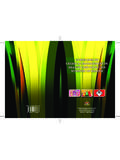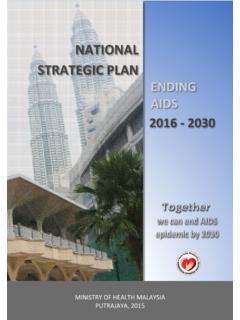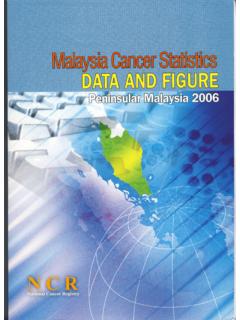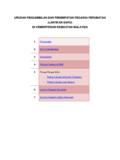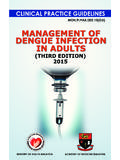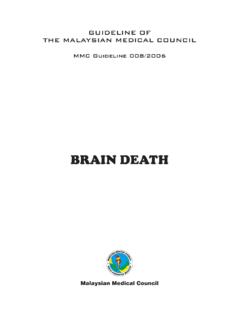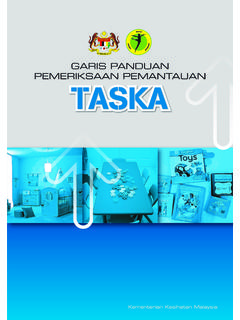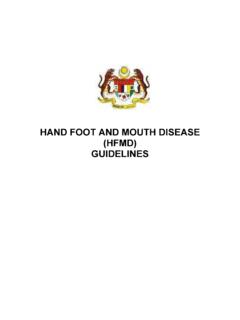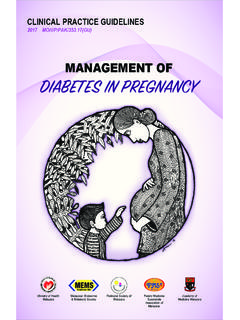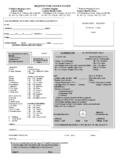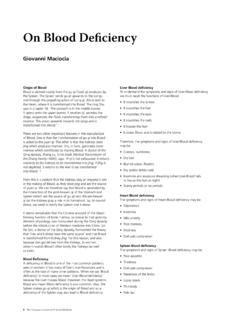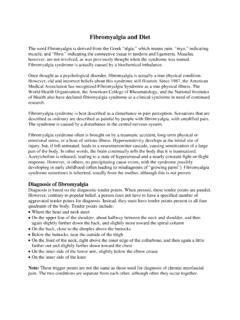Transcription of LEPTOSPIROSIS - moh.gov.my
1 LEPTOSPIROSISDr SharifahFaridahbtSyedOmarInfectious Diseases LecturerDepartment of MedicineUniversity Malaya Medical Centre LEPTOSPIROSIS Epidemiology Pathophysiology Clinical presentation and Diagnosis Management Introduction Zoonosiscaused by spirochetes of the genus, Leptospira First described by Adolf Weil in 1886 an acute infectious disease with enlargement of spleen, jaundice and nephritis One of the emerging infectious diseases since the late 1990s 1995: Nicaragua epidemic of severe pulmonary haemorrhagesyndrome (SPHS) 1990 s: Leptospirosisamong US inner-city homeless population 1998: outbreak amongst participants of the Lake Springfield Triathlon Recent large outbreaks in several Asian, Central and South American countries Becoming an important public health problem, yet it continues to be under recognized by policy makers due to the poor quality of surveillance data CDC Update: Outbreak of Acute Febrile Illness Among Athletes Participating in Eco-Challenge-Sabah 2000 Borneo, Malaysia, 2000 that Leptospirawere the cause of illness and that water from the SegamaRiver was the primary source of infection.
2 Participants in adventure sports and exotic tourism should be aware of potential exposure to unusual and emerging infectious agents. MARAN, 10 JULY, 2010: Six villagers have died of LEPTOSPIROSIS and melioidosis within a week of joining in the search for a drowning victim in the Lubuk Yu recreational forest near here, Health Minister Datuk Seri Liow Tiong Lai revealed today . Epidemiology No precise estimates of the global burden of human LEPTOSPIROSIS Becoming a common public health problem worldwide Estimated annual incidence (WHO) to 1 per 100 000 per year in temperate climates 10 or more per 100 000 per year in the humid tropics Estimated case-fatality rates in different parts of the world have been reported to range from <5% to 30% Seasonal peak in summer, during rainy/monsoon season Figures are grossly underestimated : Overlooked and underreported Why the lack of recognition?
3 Clinical manifestation wide and varied May mimic many other diseases, dengue fever and other viral haemorrhagic diseases Diagnostic capabilities are not readily available (especially in countries where the disease is highly endemic) poor surveillance and reporting of cases Occupational hazard miners, sewer workers, farmers, vets, rice field workers, soldiers etc Recreational exposures water sports, canoeing, white water rafting Spread from traditional rural base cause of epidemics in poor urban slum communities in developing countriesMore than half of the cases were Bangkok residents and did not travel outside Bangkok in the preceding 2 weeks. The majority of the cases presented in late rainy season. LEPTOSPIROSIS in the urban area is common and should be recognized, particularly in rainy season. Wild mammals are the maintenance host or primary reservoir for the spirochetes Pathogenic leptospires are maintained in nature in the renal tubules of certain animals Rats/rodents, cats, livestock, raccoons, dogs etc Humans become infected through direct contact with the infected urine or indirectly through contact with contaminated water Enters through mucous membrane or abraded skin Microbiology Leptospiresare bacteria which can be either pathogenic or saprophytic There are over 200 pathogenic serovarsdivided into 25 serogroups Certain serovarmay develop a commensalor comparatively mild pathogenic relationship with a certain animal host species Eg.
4 Cattle often associated with serovarhardjo, dogs with canicolaand rats with icterohaemorrhagiaeand copenhageni Other ways of classifying leptospires: Species classification: based on DNA homologyThe two classification systems based on the serovar and species concepts are not always in agreement and strains belonging to the same serovar may belong to different Leptospira species PATHOPHYSIOLOGY Infection leptospires appear in the blood invade all tissues and organs particularly affecting the liver and kidney cleared from the body by the host's immune response May also settle in the convoluted tubules of the kidneys shed in the urine for a few weeks to several months or longer Subsequently cleared from the kidneys and other organs (may persist in the eyes for much longer) PATHOPHYSIOLOGY Produces endotoxin attach onto the endothelial cells capillary vasculitis (endothelial necrosis and lymphocytic infiltration)
5 Vasculitis and leakage petechiae, intraparenchymal bleeding and bleeding along serosa and mucosa Lost of fluids into the third space hypovolaemic shock and vascular collapse Humans react to an infection by producing specific anti-Leptospira antibodies Seroconversion as early as 5 7 days after the onset of disease sometimes only after 10 days or longer IgM appear somewhat earlier than IgG and generally remain detectable for months or even years but at low titre. Clinical Presentation and Diagnosis Diagnostic challenges early-phase LEPTOSPIROSIS : non-specific presentation frequent cause of undifferentiated febrile illness in developing countries Misdiagnosis in regions where dengue and other infectious diseases with overlapping presentations are endemic Co-infection with other diseases such as scrub typhus, dengue and malaria Timely diagnosis is essential antibiotic therapy provides greatest benefit when initiated early in the course of illness Diagnosis of leptospirosistherefore depend on a high index of suspicion among clinicians and the availability of an accurate point-of-care test Clinical Features Incubation Period: usually 5-14 days.
6 Range: 2-20 days Biphasic clinical course Acute or septicemic phase lasting about 1 week Immune phase when antibodies are produced and leptospires are excreted in the urine (6days-4weeks) Most complications are associated with localisation of leptospires within the tissue during the immune phase Clinical syndromes Anicteric LEPTOSPIROSIS Self limiting, symptoms non specific Majority of infection Usually lasts 1-2 weeks Aseptic meningitis seen in 25-50% Mortality almost nil extremely rare (some reported cases of death due to pulmonary haemorrhage) Icteric LEPTOSPIROSIS Weil s disease 5-10% of patients with LEPTOSPIROSIS 5-15% mortality Biphasic clinical course may be indistinguishable Jaundice, renal failure, (pulmonary) haemorrhage Other organs cardiac, ocular, cause for abortion in pregnancy, acalculous cholecystitis, pancreatitis Typically, the disease presents in four broad clinical categories: (i) a mild, influenza-like illness; (ii) Weil's syndrome characterized by jaundice, renal failure, haemorrhage and myocarditis with arrhythmias; (iii) meningitis/meningoencephalitis; (iv) pulmonary haemorrhage with respiratory failure.
7 Common symptoms and signs fever severe headache myalgias conjunctivalsuffusion jaundice general malaise stiff neck chills abdominal pain joint pain anorexia nausea vomiting diarrhoea oliguria/anuria haemorrhages skin rash photophobia cough cardiac arrhythmia hypotension mental confusion psychosis DeliriumNo presentation of leptospirosisis diagnostic and clinical suspicion must be confirmed by laboratory testsMultiorgan involvement Ocular Suffusion dilation of the conjunctival vasculature, subconjuctival haemorrhage, uveitis Icterus scleral with conjunctival suffusion-pathognomic of Weil s disease GI Jaundice not associated with hepatocellular necrosis. Bilirubin, ALT, AST will normalise Renal Acute tubular necrosis (direct leptospire injury) Interstitial nephritis (relate to Ag-Ab complexes) Cardiac Myocarditis, 1stdegree heart block, coronary arteritis Pulmonary Spectrum ranging from cough, dyspnoea, haemoptysis to ARDS Pulmonary haemorrhage may cause death Radiology reveals diffuse small opacities which may disseminate or coalesce a sign of intra-alveolar and interstitial haemorrhage Prognosis The virulence factors in leptospires are poorly understood Mortality is dependent on many factors Some serovars generally tend to cause mild disease and others severe disease (icterohaemorrhagiae and copenhageni ).
8 However, there are no serovar specific presentations of infection and any serovar may cause mild or severe disease in different hosts Prognosis Patient factors old age, multiple underlying medical problems, nutritional status The infection dose Renal failure, HyperK, Plt, cardiac failure with hypotension and arrhythmia, and SPHS may be contributory factors to the mortality rate Neurological ( disturbance of consciousness, delirium and stiffness of the neck) and GI symptoms ( GI bleeding, repeated nausea and vomiting, abdominal pain and hiccups) Prognostic Factors in LEPTOSPIROSIS : A Study From Kerala, India Moderate and severe disease Mortality : 15%, suggests of a higher mortality > 50 yrs Gender, at-risk occupation, rodent exposure or interval to penicillin therapy were not significant predictors of mortality CPK, Na, K and platelet counts were significantly different between the two groups On multivariate analysis, organ dysfunction, hyponatremia, elevated CPK, bleeding manifestations, cardiac or neurologic dysfunction were significant predictors of mortality Identification of patients who can be predicted to do poorly helps focus intense treatment to improve outcomeInfectious Diseases in Clinical Practice:May 2005 -Volume 13 -Issue 3 -pp 104-107 Unnikrishnan, Dilip MD et alLaboratory Inadequate laboratory test.
9 Major barrier for diagnosis and epidemiologic surveillance The disease is usually diagnosed by detecting antibodies culturing the bacteria from blood, urine or tissues demonstrating the presence of leptospiresin tissues using antibodies labelledwith fluorescent markers polymerase chain reaction (PCR) immunostaining Methods for the direct detection of leptospires are either slow or of limited reliability thereforeserology is often the most appropriate diagnostic method MAT-Microscopic agglutination test "gold standard of serodiagnosis unsurpassed diagnostic (serovar/serogroup) specificity in comparison with other available tests Sensitivity 92% Specificity 95% Unable to differentiate between agglutinating antibodies due to current, recent or past infections Two consecutive serum samples should be examined look for seroconversion or a four-fold or greater rise in titre Single titre: Different cut-off points.
10 1:100, 1:200, 1:400 or 1:800 as diagnostic of current or recent LEPTOSPIROSIS ELISA Popular and several assays available Based on a genus-specific antigen Detect IgM antibody and sometimes also IgG antibodies in the early phase of the disease Some systems are less specific than the MAT Weak crossreactions due to the presence of other diseases may be observed ELISA results should be confirmed by the MAT Direct methods of detecting leptospires Culture, dark-field microscopy, inoculation of experimental animals, (immuno)staining and the polymerase chain reaction (PCR) Dark-field microscopy Leptospires are observed as thin, coiled, rapidly moving microorganisms in fluids suchas culture medium, blood or urine using dark-field microscopy Technically demanding, false-positive and false-negative diagnoses are easily made Always confirmed by other tests Dark field microscopy Treatment Appropriate chemotherapy and supportive therapy help reduce the mortality of severe cases Early treatment is very important If not treated appropriately within the first 2-3 days, it may progress in severity Antibiotics Treatment with effective antibiotics should be initiated as soon as the diagnosis of LEPTOSPIROSIS is suspected and preferably before the fifth day after the onset of illness The benefit of antibiotics after the fifth day of the disease is controversial -However.
